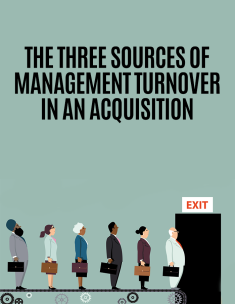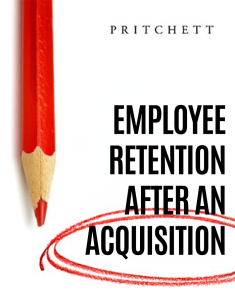Rule one of Barron’s 10 Rules for Investors says, “The success of a company is dependent nine parts on management and one part on all other factors, including luck.”
If that’s true for companies in general, it is particularly true for firms that are being merged or acquired. As far back as the conglomerate period of the go-go 1960s, Leighton and Tod affirmed this belief in a Harvard Business Review article. They wrote:
We cannot overestimate the importance of getting to know the president and his key personnel. Evidence indicates that the more fully the parent company understands their emotional and personal, needs their weaknesses and strengths, their fears and apprehensions, the more effectively it will be able to help with the acquisition and to manage the company later on.
A number of pressing questions desperately need to be answered:
- Who should stay?
- Who should go?
- Who shall decide, and how?
- What new managerial demands will a merger bring about?
- What sort of managerial efficiencies or economies of scale can be achieved?
- What new management talents will the merger call for: market-realizing savvy, technical expertise, financial acumen, turnaround artistry, team building, a more broad-gauged perspective, fast-growth capability, management of change?
- What kind of management potential has been acquired? And what does it imply for long-range personnel planning?
- How can the newly acquired retinue of managers best be managed and motivated?
- How does one play to their strengths and shore up their weaknesses?
- Will the right personal chemistry and compatibility be there? Can I work with these people?
The answers to some of these questions, of course, hinge on other issues that must be addressed, such as the following:
- To what extent will the organizations be merged?
- Will the acquisition be run on a centralized basis or be allowed extensive operating autonomy?
- What control policies and procedures will be implemented to guide the subsidiary?
- What operations or functions are overlapping—how will the parent company ascertain which facilities, departments, and so on, will be abolished, expanded, or left as they are?
Management should establish well-defined criteria by which to evaluate the human resource aspects of the merger. Parent company objectives must be identified as a preliminary step and conclusions drawn regarding how these objectives can best be achieved.
Assuming that the acquiring firm has developed a strategic road map that addresses the integration issues mentioned above, the next order of business is to make a thorough assessment of key management and technical talent that initially comes with a new acquisition. Part of this appraisal should be a determination of how much of this talent could be retained.
Bailouts
One of the most likely bailout points is in the top management ranks. Key executives who fought the merger/acquisition often feel that their relationship with the parent company has been strained beyond repair and that they have too many fences to mend. Feeling that their career is on shaky ground, and without any quick and convincing messages to the contrary from top management in the parent company, they bolt.
The acquirer is frequently taken aback by this turn of events. Parent company executives may believe the relationship is developing quite well and think they have made it plain that they bear no residual ill will. In fact, parent company management sometimes assumes it has done more than is necessary to prevent key managers in the target firm from jumping ship. But assumptions can be extremely costly when dealing with acquisitions, particularly ...





